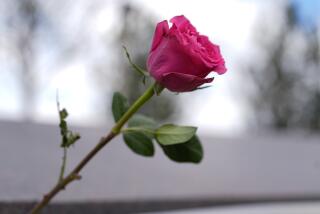Classmates’ Burns Provide Painful Lesson
When burn victims Bartisha Nolen, 8, and her sister, Debra Summers, 5, enrolled at Hazeltine Avenue Elementary School in Van Nuys two weeks ago, the students and teachers weren’t sure how to act.
Some pupils stared at the girls and the scars they had suffered in a house fire in Bakersfield in July, 1984. Others ignored them.
On the playground, children shied away from Bartisha, a third-grader who must wear a clear plastic pressure mask to minimize scarring on her badly burned face. In the classroom, kindergartners would edge away from Debra, who is undergoing skin grafts on her arms and forehead.
Even some teachers ignored the children, said Allison Marks, a school district counselor.
The children’s family moved to Van Nuys last summer to be near the burn center at Sherman Oaks Community Hospital, where the children and their mother are being treated.
Education Program
On Monday, the school conducted a program to help students and teachers understand and accept the little girls’ appearance.
Burn victims’ injuries heal, but they “never, ever look the same again,” Barbara Kammerer, who conducted the program, told the assembled pupils.
Kammerer was sent to the school by the Alisa Ann Ruch Burn Foundation in Canoga Park. Its 4-year-old school re-entry program has assisted more than 70 burn victims from nursery school through college age. Kammerer is a Huntington Beach teacher who suffered second- and third-degree burns over 40% of her body in a 1977 automobile accident.
In a series of talks to each grade, Kammerer explained the girls’ injuries and the painful treatment they are undergoing. Bartisha and Debra, daughters of Lucenda Summers and Don Nolen, were out of school for treatments.
“Their baby brother was killed in the fire,” Kammerer told an audience of attentive fourth-graders. “Their mom was burned very badly. They have really gone through a lot of pain--not just physical pain but pain in their hearts. Bartisha and Debra are extremely courageous.”
Bartisha must wear the plastic mask 24 hours a day, Kammerer said.
“She sleeps with it, eats with it,” Kammerer said. “She’ll probably have to wear it a year or more.”
When they see Bartisha and Debra in school, Kammerer told the children that it is “OK to look. It’s not OK to stare. If you do look at them, include a warm ‘hello, how are you?’ Imagine how you would want other people to treat you.”
“Yeah, normal,” said a boy.
“You’ve got the idea,” Kammerer said.
Kammerer told the students how self-conscious she felt when she returned to teaching after her accident. She had lost the fingers on her right hand. It was reconstructed, but her left hand still was disfigured. Her entire face had been reconstructed. When she returned to the classroom, Kammerer said, she was dressed head to toe in a pressure suit, a thick girdlelike garment that, like the mask, minimizes scarring.
‘I Was Terrified’
“I was terrified,” she said. “I was afraid that people might point, whisper, laugh, not like me or hurt my feelings. So I decided to sit down with my students that first day and tell them exactly what I’d been through. It worked.”
Kammerer showed slides of burn victims in various stages of treatment. Some of the pictures made the students gasp. She also told the children to “stop, drop and roll” if their clothes catch fire and to cool burns in cold water for 15 or 20 minutes.
“There are three things you never put on a burn,” she said: “butter, grease or ice.”
Kammerer also answered the children’s questions candidly.
“Did your hair catch on fire?” a fifth-grade girl asked.
“Yes,” she said, “but mine grew back. If the hair follicles are destroyed, it won’t grow back. Then you have to wear a wig.”
More to Read
Sign up for Essential California
The most important California stories and recommendations in your inbox every morning.
You may occasionally receive promotional content from the Los Angeles Times.










